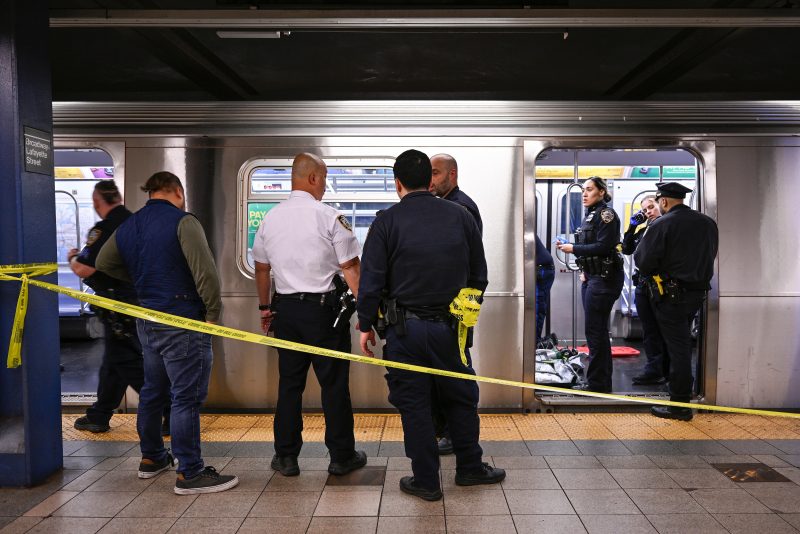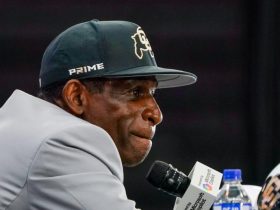Three days before Christmas, 1984, Bernhard Goetz was riding the 2 train downtown when four teenagers confronted him. Despite this incident becoming a point of national debate — or because of it — it’s not entirely clear what happened at first. Goetz says the teens were mugging him, by no means an unheard of situation on the subway at the time. The teens had screwdrivers, which they would later say they planned to use to steal quarters from arcade games.
Goetz had a gun. He shot the four teenagers and then fled. After more than a week on the run, he turned himself in at a police station in New Hampshire. By then, the shooting had already become a sensation in New York — and nationally.
It’s worth reconsidering Goetz in the moment because of a historic echo that unfolded on a Manhattan F train this week. Jordan Neely, a homeless man with a history of mental illness often seen impersonating Michael Jackson, entered the train car and reportedly began complaining loudly about being frustrated, about being hungry and thirsty.
Here, too, details are sketchy. Passengers reportedly called 911 to report that Neely was harassing people on the train. At some point a passenger on the train, reportedly a former Marine, subdued Neely by putting him in a chokehold. Neely lost consciousness and later died.
The parallels between the two incidents are imperfect but obvious. In each case, a subway passenger perceived a threat and reacted to it. In each case, the incident unfolded in a broader climate of concern about public safety, particularly on the subway. And in each case there was an element of race. Both the passenger who subdued Neely and Goetz were White. Those they injured were Black.
In the first weeks after the Goetz shooting, public opinion was divided — though less so in New York itself. A Washington Post-ABC News poll conducted in January 1985 found near-universal awareness of the shooting across the country, with a slight plurality viewing the shooting with disapproval. In New York City, though, nearly half of respondents viewed it positively.
A central reason for this was that the subways really were grimy and dangerous. This was less than a decade after the infamous “Bronx is burning” era in New York City, less than a decade after the federal government declined to aid the city’s financial crisis (inspiring a famous New York Daily News cover). Crime was rising — and would continue to rise for years to come. Many New Yorkers saw Goetz’s actions as the response of an average person pushed too far.
In the immediate aftermath of Neely’s death, a similar sentiment has colored the public conversation. Neely’s actions on the train and his history of arrests have spurred not-infrequent suggestions that perhaps his being subdued was deserved or necessary. Others defending the response to Neely have claimed that he threatened violence to others on the train — claims that are unsubstantiated as of writing.
Much of the response is polarized on partisan lines. That’s in part because the concerns about subway safety that would seem to rationalize Neely’s being restrained are near universal in conservative media. Shortly before the midterm elections, as outlets like Fox News amplified fears that crime in the United States was spiking without evidence, The Washington Post noted a resurgence of fearmongering about the subways in particular.
There were a few reasons for this. One is that the right-wing New York Post covers incidents of local crime assiduously, coverage that often seeps over onto its sister outlet, Fox. Another is that “crime on the subway” is particularly useful for stoking partisan frustration. Subways are strictly an urban phenomenon and so subway crime is easily folded into a narrative about local Democratic leaders failing to contain violence.
We are also in a moment where vigilantism is celebrated on the right. At its heart, calls for more concealed weapons and the need to own firearms to keep crime in check are calls for ruggedly individualistic enforcement of the law. Kyle Rittenhouse has become a right-wing celebrity. Polling shows a surge in the percentage of gun owners who believe they need their weapons as a response to potential criminal acts — despite violent crime being far lower than it was two decades ago, including in New York City.
The racial element is inescapable. Even setting aside Neely’s social status, research has showed that people perceive Black men as more threatening relative to similarly statured White men. In multiple ways, Neely fit stereotypes of who people should fear on the subway. He was treated as someone fearsome.
It is possible that the passenger who subdued Neely will face criminal charges. His actions have met with some approval, however, as did Goetz’s. When Fox New host Sean Hannity described the incident on his show Thursday night — framing Neely in terms that highlighted his purported danger — someone in the studio audience whooped with approval after a mention of the passenger’s military record.
Here, a distinction from Goetz is useful. In 1984, New Yorkers had broad, firsthand experience with crime on the subway and so viewed Goetz more favorably in the immediate aftermath of the attack than did Americans in general. Now, perceptions that the subway is particularly dangerous have been nationalized largely for political purposes. There’s no polling at this point, but it would not be surprising to see national Republicans more sympathetic to the passenger’s actions than New Yorkers.
In April, Siena College polling found that New York City residents were 8 points more likely to say that New York was a place they felt safe from crime rather than somewhere they didn’t. Residents of the suburbs were 6 points more likely to say they didn’t feel safe.
There was another reason that Goetz earned the public’s sympathy in January 1985 that’s worth highlighting: details of what unfolded were still vague. It wasn’t until March that his admissions to New Hampshire police became public, including that, after opening fire, he noticed that one of the four teenagers wasn’t visibly bleeding.
“You don’t look too bad,” Goetz told the teen, Darrell Cabey. “Here’s another one.” He then shot him in the back.
Cabey was paralyzed and, in 1996, successfully sued Goetz. Goetz remained unrepentant even during that trial, saying that “it would have been better off than the situation we have now” had the teens been aborted before birth. He was acquitted of attempted murder charges in a 1987 trial but served time for illegally possessing the handgun he used in the shooting.
Neely died less than a week ago, less than the period before Goetz turned himself in in New Hampshire. It’s useful to remember, as perceptions of Neely’s death firm up in an era of relentless partisanship and split-second media coverage, that we — like New Yorkers in late December 1984 — still can’t say with confidence that we know exactly what happened.
Emily Guskin contributed to this report.








